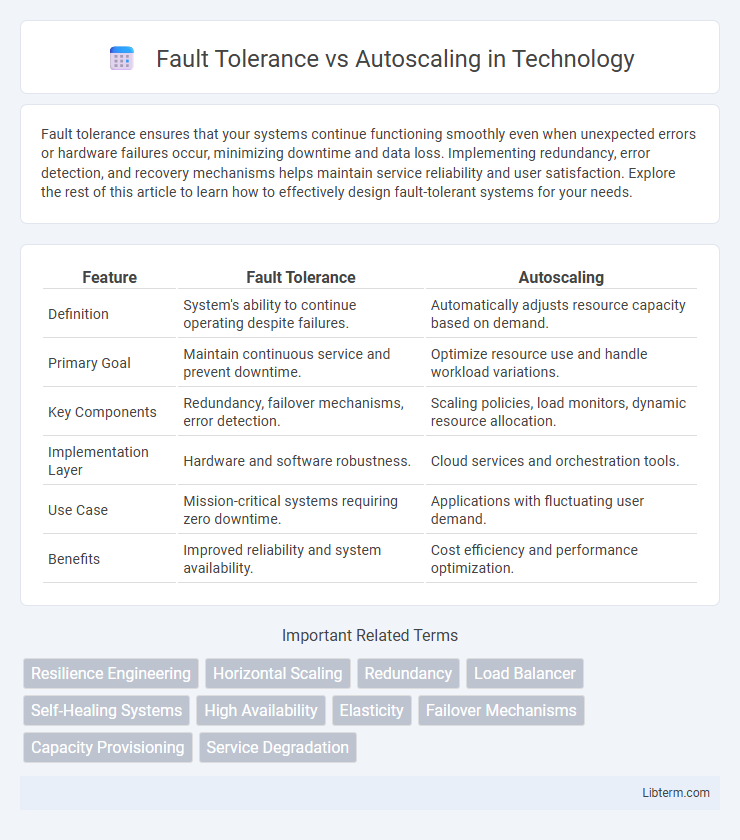Fault tolerance ensures that your systems continue functioning smoothly even when unexpected errors or hardware failures occur, minimizing downtime and data loss. Implementing redundancy, error detection, and recovery mechanisms helps maintain service reliability and user satisfaction. Explore the rest of this article to learn how to effectively design fault-tolerant systems for your needs.
Table of Comparison
| Feature | Fault Tolerance | Autoscaling |
|---|---|---|
| Definition | System's ability to continue operating despite failures. | Automatically adjusts resource capacity based on demand. |
| Primary Goal | Maintain continuous service and prevent downtime. | Optimize resource use and handle workload variations. |
| Key Components | Redundancy, failover mechanisms, error detection. | Scaling policies, load monitors, dynamic resource allocation. |
| Implementation Layer | Hardware and software robustness. | Cloud services and orchestration tools. |
| Use Case | Mission-critical systems requiring zero downtime. | Applications with fluctuating user demand. |
| Benefits | Improved reliability and system availability. | Cost efficiency and performance optimization. |
Understanding Fault Tolerance and Autoscaling
Fault tolerance ensures system stability by automatically detecting and recovering from hardware or software failures, minimizing downtime and data loss. Autoscaling dynamically adjusts computing resources based on workload demand to maintain performance and cost efficiency. Both mechanisms are critical in cloud architecture, with fault tolerance focusing on reliability and autoscaling on resource management.
Core Principles of Fault Tolerance
Fault tolerance centers on designing systems to continue operating properly in the event of hardware or software failures by incorporating redundancy, error detection, and failover mechanisms. Core principles include fault isolation to prevent cascading failures, graceful degradation to maintain partial functionality, and recovery strategies like checkpointing and replication. In contrast to autoscaling, which dynamically adjusts resources based on demand, fault tolerance emphasizes system reliability and uptime regardless of load conditions.
How Autoscaling Works in Cloud Environments
Autoscaling in cloud environments automatically adjusts computing resources based on real-time demand by monitoring metrics like CPU usage, memory load, and network traffic. It dynamically provisions or decommissions instances to maintain optimal performance and cost efficiency without human intervention. This process ensures applications handle variable workloads seamlessly, preventing over-provisioning and underutilization.
Key Differences Between Fault Tolerance and Autoscaling
Fault tolerance ensures system reliability by allowing continuous operation despite hardware or software failures through redundancy and failover mechanisms. Autoscaling dynamically adjusts computing resources based on real-time demand to maintain optimal performance and cost-efficiency. While fault tolerance prioritizes uninterrupted service during failures, autoscaling focuses on scaling resource capacity to handle workload fluctuations.
Benefits of Implementing Fault Tolerance
Implementing fault tolerance enhances system reliability by enabling continuous operation despite hardware or software failures, reducing downtime and preventing data loss. This approach improves customer satisfaction and trust by ensuring consistent service availability even under stress or unexpected issues. Fault tolerance complements autoscaling by maintaining system stability while resources dynamically adjust to varying loads, resulting in a resilient and scalable infrastructure.
Advantages of Autoscaling for Cloud Applications
Autoscaling enhances cloud application reliability by dynamically adjusting resource allocation based on real-time demand, preventing over-provisioning and reducing operational costs. It ensures continuous performance and availability during traffic spikes by automatically scaling up resources without manual intervention. Autoscaling also supports efficient fault recovery, as it can rapidly replace unhealthy instances, maintaining application stability and user experience.
Fault Tolerance vs Autoscaling: Use Case Scenarios
Fault tolerance ensures system reliability by maintaining continuous operation during hardware or software failures, ideal for mission-critical applications like financial transactions and healthcare systems. Autoscaling dynamically adjusts computing resources based on demand, optimizing performance and cost-efficiency in cloud environments such as e-commerce platforms during traffic spikes. Combining fault tolerance with autoscaling provides robust resilience and scalability, essential for large-scale distributed applications and real-time data processing pipelines.
Design Patterns for Resilience and Scalability
Fault tolerance design patterns such as Circuit Breaker and Bulkhead isolate system components to maintain functionality during failures, ensuring continuous operation without service disruption. Autoscaling leverages monitoring metrics like CPU usage and request rates to dynamically adjust resources, enabling systems to handle variable loads efficiently and maintain performance. Combining fault tolerance with autoscaling enhances overall system resilience and scalability by preventing cascading failures while adapting to demand in real time.
Best Practices for Combining Fault Tolerance and Autoscaling
Combining fault tolerance and autoscaling ensures robust cloud infrastructure by maintaining application availability during failures while dynamically adjusting resources based on demand. Best practices include implementing health checks to trigger autoscaling events and integrating redundancy across multiple availability zones to prevent single points of failure. Leveraging orchestration tools like Kubernetes with auto-healing and horizontal scaling capabilities optimizes both fault resilience and resource efficiency.
Choosing the Right Approach for Your Infrastructure
Choosing between fault tolerance and autoscaling depends on your infrastructure's primary needs: fault tolerance ensures continuous operation by replicating components and handling failures without downtime, ideal for mission-critical systems requiring high availability. Autoscaling dynamically adjusts resources based on demand, optimizing cost efficiency and performance for variable workloads typical in cloud environments. Evaluating your application's tolerance for downtime, workload variability, and budget constraints helps determine whether a fault-tolerant setup, autoscaling strategy, or a hybrid approach best aligns with your infrastructure goals.
Fault Tolerance Infographic

 libterm.com
libterm.com